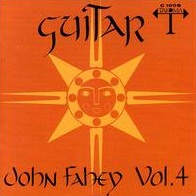History
The album begins Fahey's interest in soundscapes and sound effects, using backward tapes and dissonance. Richie Unterberger, in his Allmusic review, stated: "Edited together from several pieces, the 19-minute "The Great San Bernardino Birthday Party" anticipated elements of psychedelia with its nervy improvisations and odd guitar tunings." [1] Fahey himself called it "a histrionic, disorganised outpouring of blather" [2] although he had kind things to say of some of the other songs. Unterberger also states "Despite Fahey's curmudgeonly dismissal of the record several decades later, it's an important, if uneven, effort that ultimately endures as one of the highlights of his discography."
Fahey, ED Denson and Barry Hansen assembled the record shortly after the release of The Transfiguration of Blind Joe Death from both new music and parts that had been on tape for years. [3]
Alan Wilson, who appears on this recording and was a member of the band Canned Heat, had once assisted Fahey in his UCLA master's thesis on the music of Charley Patton. [4] Fahey and Wilson duet on "Sail Away Ladies"; this version of the tune displays an eastern influence, with Wilson playing the South Indian veena. This track became a lifelong favourite of the British DJ John Peel, whose championing of Fahey's music on his influential BBC radio shows helped the guitarist gain an audience outside the United States. Peel included "Sail Away Ladies" in his 1999 Peelenium, a personal selection from 100 years of recorded music. [5]
Reception
Music critic Glenn Astarita, writing for All About Jazz about the album's reissue, said that "despite the inferior audio quality on some of these tracks, it is always a joy to hear this great musician reinvent previously explored terrain. Here, we are provided with a snapshot of a period in music when The Beatles were hot, and the dawning of the psychedelic age was upon us. Simply put, John Fahey pushed the acoustic guitar to its limits via his trail blazing applications and investigative spirit..." [10] In his retrospective review for AllMusic, music critic Richie Unterberger referred to the album as a "hodgepodge of tracks" but also stated, "Nevertheless, it stands as his most, well, far-out work, and one of his most innovative... The six briefer pieces that comprised the rest of the record also broke ground with their unsettling moods and dissonances..." [1]
Despite his disdain for hippies and the 1960s hippie culture, then and later in life, [11] The Great San Bernardino Birthday Party & Other Excursions was marked as psychedelic despite Fahey's remonstrances. Kevin Hainey of Exclaim! called it one of the "Eleven Sturdy Pillars of Psych-Folk" and "...this is the only [one] that blatantly flirts with psychedelia. It’s also the only to enlist other musicians, adding occasional flute, organ and veena to Fahey’s most 'out there' early excursions." [12] In his 1998 story for The Wire , Edwin Pouncey referred to it as "tinged with an enduring hippy mystique." [4]
This page is based on this
Wikipedia article Text is available under the
CC BY-SA 4.0 license; additional terms may apply.
Images, videos and audio are available under their respective licenses.
